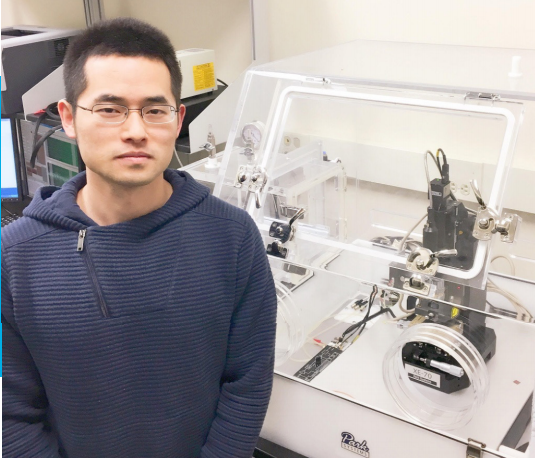CHNEGLIN YI
Chneglin Yi is a Research and Teaching Assistant at the Department of Mechanical Engineering Thomas J. Watson School of Engineering and Applied Science State University of New York and is a PhD Candidate
HIS RESEARCH FOCUS IS ON EXPERIMENTAL NANOMECHANICS OF NOVEL 1D AND 2D NANOSTRUCTURES, TESTING THE MECHANICAL PROPERTIES AND INTERFACES, INVESTIGATE THE FUNDAMENTAL MECHANICAL PROPERTIES OF CARBON NANOTUBES (CNTS) AND BORON NITRIDE NANOTUBES (BNNTS) AND THEIR METAL COMPOSITES BY USING MULTISCALE EXPERIMENTAL APPROACHES.
Nanomechanical Folding and Unfolding of Graphene on Flat Substrate
Graphene is a type of two-dimensional nanostructure with extraordinary physical properties, and is promising for a number of applications. Due to its ultra-thin characteristics, graphene can easily fold under external stimuli such as mechanical forces. The substantial local deformation in folded graphene has a prominent influence on its electrical properties. Understanding and ultimately having a good command of the mechanical deformation in folded graphene is of importance tothe design and manufacturing of graphene origami and its functional mechanical and electrical properties. The study focuses on investigating the local folding and unfolding behaviors of few-layer graphene sheets by using atomic force microscopy (AFM) techniques. The bending rigidity of few-layer graphene and the interlayer shear interaction during the graphene folding process are studied. The results reveal that the bending stiffness of two to six layers graphene follows a square-power relationship with its thickness. The study demonstrates that it is a plausible venue to qualify the pure bending stiffness of graphene through measuring its self-folding conformation on flat substrates. The nanomechanical measurements also reveal that individual graphene sheets can be mechanically folded in a buckling delamination mode, which leads to accordion-shape self folded graphene on flat substrates. This work is useful to better understand the structural and mechanical properties of graphene, and in the pursuit of its applications, in particular, as programmable nanoscale origami structures.
How do you think your research will impact society in a positive way?
With the development of nanotechnology, nanomaterial has been widely studied by lots of research groups. But the fundamental research still remains limited. I think our research is quite important for the applications of nanomaterials (Carbon nanotubes, Graphene,etc). Since during the manufacture process of graphene based devices, especially in aerospace and automobile industries, folding and unfolding phenomenon cannot be avoided. In our study, we quantitatively explored the folding and unfolding process by using atomic force microscopy (AFM) techniques. The research findings are useful to the study of active and controllable folding of graphene and in the pursuit of graphene origami with complex geometries.
What is the best or most useful part of using Park AFM for your research?
For our research, Park AFM is not only used for topographic images of sample, but also worked as a nano-manipulator. So the availability of accurate force control is quite important for us.With the powerful software (XEI), we can take advantage of Park AFM to applied normal load on the sample in order to fold and unfold the graphene and record the corresponding topography and lateral force profiles, which is the key data for our study.





